Partnership in Health & Social Care: Analyzing Mr. Ian's Case Study
VerifiedAdded on 2024/06/03
|18
|4807
|328
Report
AI Summary
This report provides an analysis of partnership working within the health and social care sector, utilizing the case of Mr. Ian to highlight the consequences of failures in collaborative practices. It explores the philosophy behind partnership working, evaluates different partnership relationships, and analyzes various models of partnership working. The report also reviews current legislation, organizational practices, and policies related to partnership working, including the Mental Health Capacity Act 2005 and the Health and Social Care Act 2012. Furthermore, it identifies barriers to effective partnership working and suggests strategies for improvement, emphasizing the importance of empowerment, respect, and independence for service users. The analysis reveals shortcomings in communication, coordination, and risk assessment in Mr. Ian's case, underscoring the need for better training, recording, and supervision within health and social care organizations to ensure the well-being of individuals.

Working in Partnership in Health and
Social Care
Social Care
Paraphrase This Document
Need a fresh take? Get an instant paraphrase of this document with our AI Paraphraser
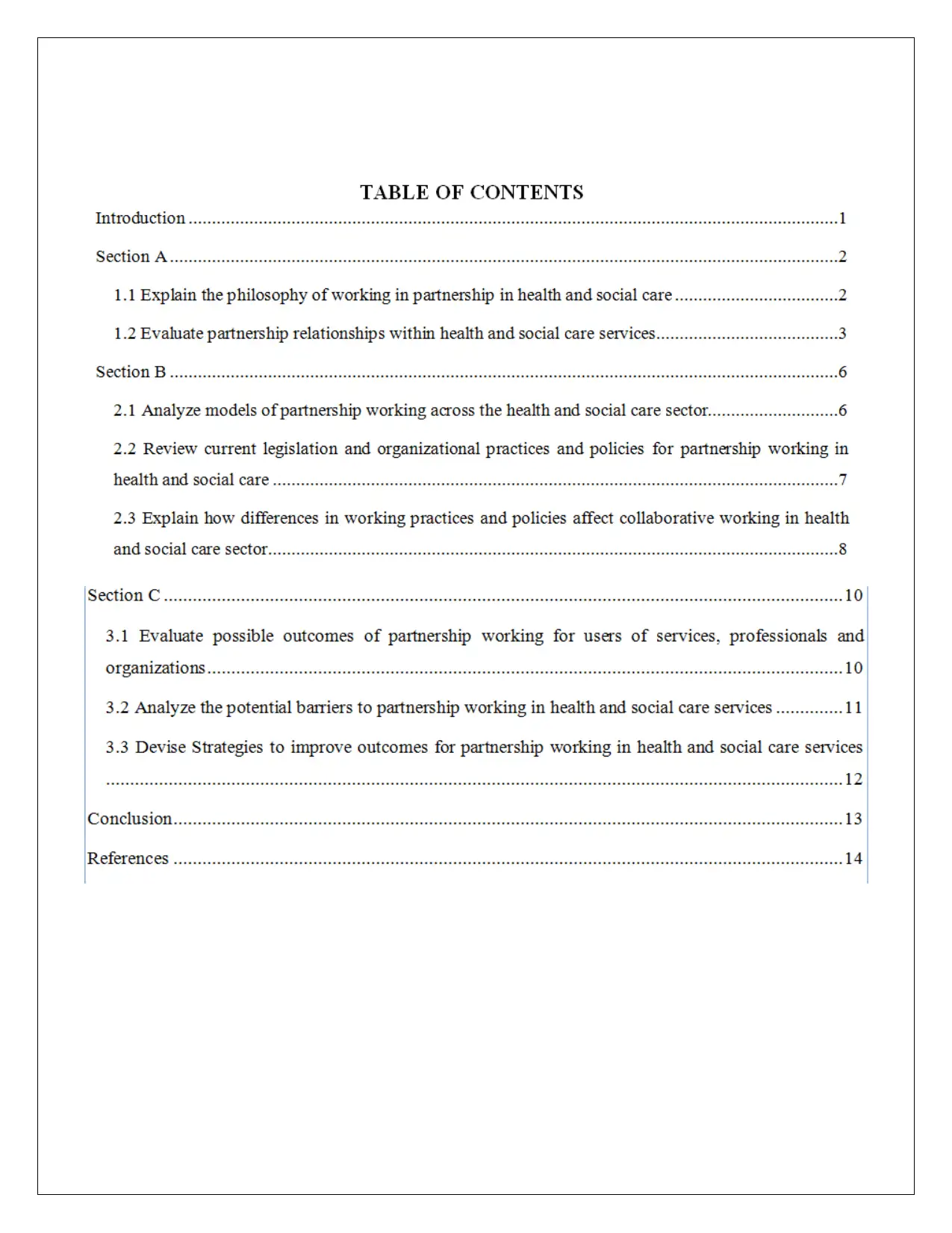

LIST OF FIGURES
Figure 1: Three levels of partnerships.........................................................................................................3
Figure 2: Models of partnership working....................................................................................................6
Figure 3: Barriers to partnership working.................................................................................................11
Figure 1: Three levels of partnerships.........................................................................................................3
Figure 2: Models of partnership working....................................................................................................6
Figure 3: Barriers to partnership working.................................................................................................11
⊘ This is a preview!⊘
Do you want full access?
Subscribe today to unlock all pages.

Trusted by 1+ million students worldwide
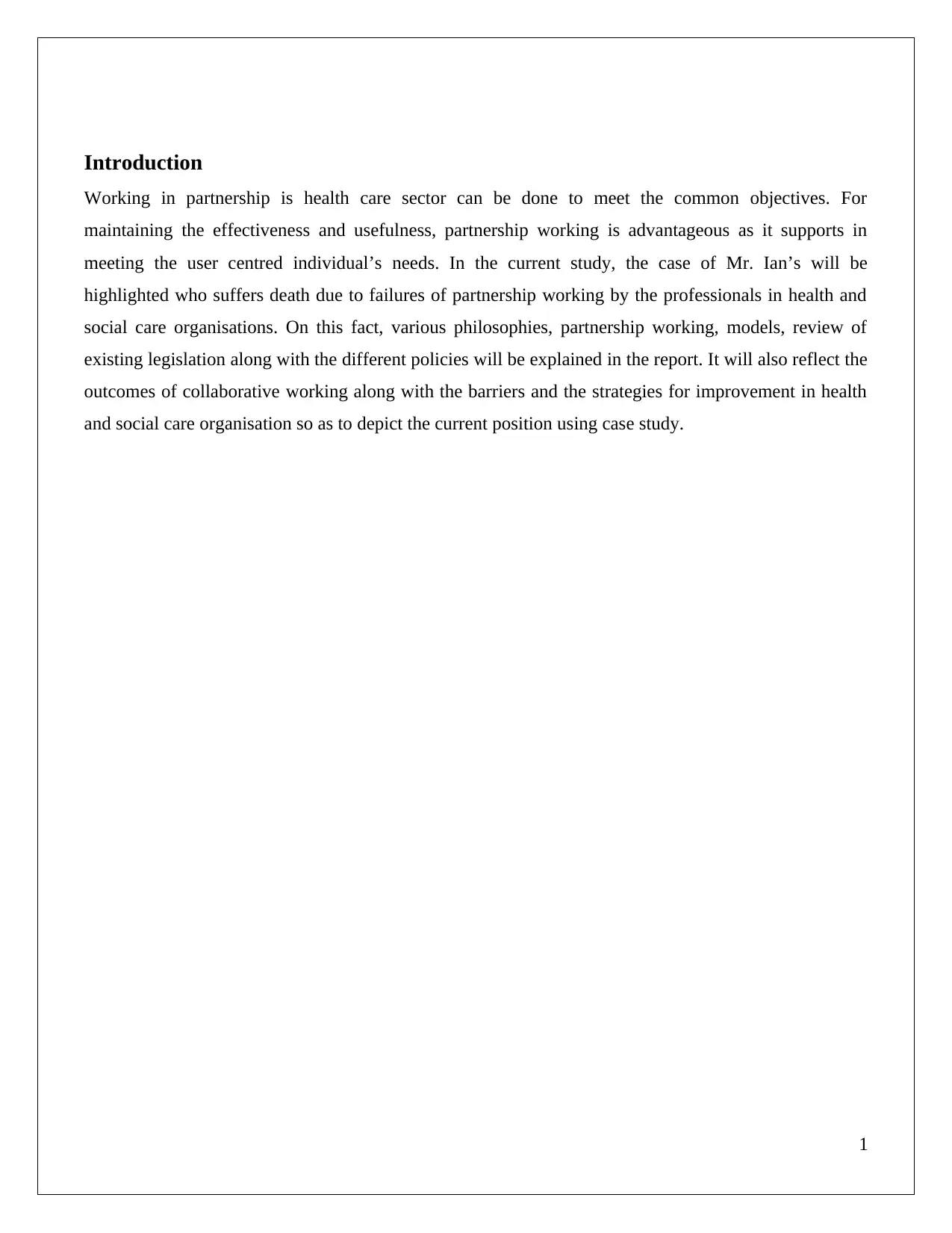
Introduction
Working in partnership is health care sector can be done to meet the common objectives. For
maintaining the effectiveness and usefulness, partnership working is advantageous as it supports in
meeting the user centred individual’s needs. In the current study, the case of Mr. Ian’s will be
highlighted who suffers death due to failures of partnership working by the professionals in health and
social care organisations. On this fact, various philosophies, partnership working, models, review of
existing legislation along with the different policies will be explained in the report. It will also reflect the
outcomes of collaborative working along with the barriers and the strategies for improvement in health
and social care organisation so as to depict the current position using case study.
1
Working in partnership is health care sector can be done to meet the common objectives. For
maintaining the effectiveness and usefulness, partnership working is advantageous as it supports in
meeting the user centred individual’s needs. In the current study, the case of Mr. Ian’s will be
highlighted who suffers death due to failures of partnership working by the professionals in health and
social care organisations. On this fact, various philosophies, partnership working, models, review of
existing legislation along with the different policies will be explained in the report. It will also reflect the
outcomes of collaborative working along with the barriers and the strategies for improvement in health
and social care organisation so as to depict the current position using case study.
1
Paraphrase This Document
Need a fresh take? Get an instant paraphrase of this document with our AI Paraphraser
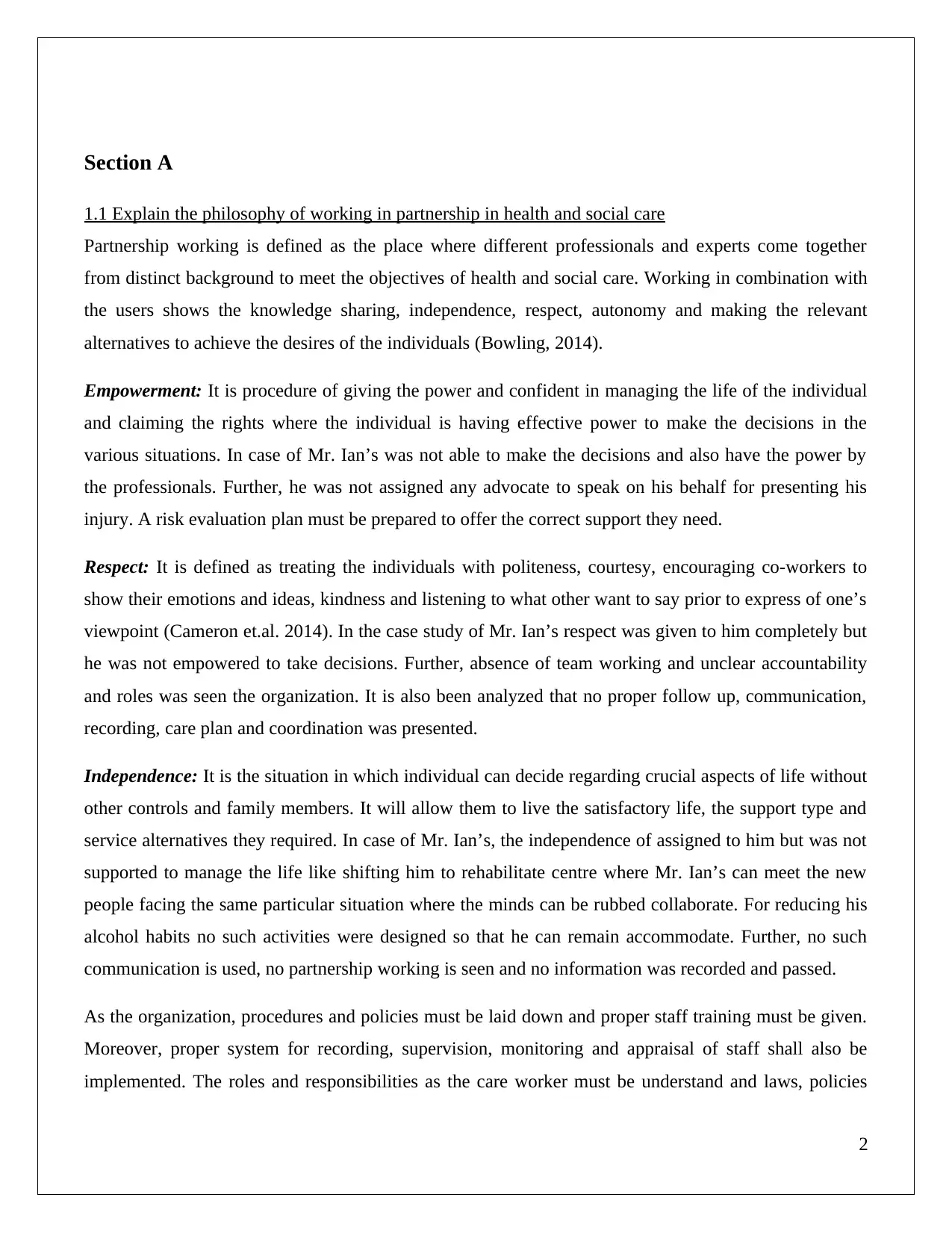
Section A
1.1 Explain the philosophy of working in partnership in health and social care
Partnership working is defined as the place where different professionals and experts come together
from distinct background to meet the objectives of health and social care. Working in combination with
the users shows the knowledge sharing, independence, respect, autonomy and making the relevant
alternatives to achieve the desires of the individuals (Bowling, 2014).
Empowerment: It is procedure of giving the power and confident in managing the life of the individual
and claiming the rights where the individual is having effective power to make the decisions in the
various situations. In case of Mr. Ian’s was not able to make the decisions and also have the power by
the professionals. Further, he was not assigned any advocate to speak on his behalf for presenting his
injury. A risk evaluation plan must be prepared to offer the correct support they need.
Respect: It is defined as treating the individuals with politeness, courtesy, encouraging co-workers to
show their emotions and ideas, kindness and listening to what other want to say prior to express of one’s
viewpoint (Cameron et.al. 2014). In the case study of Mr. Ian’s respect was given to him completely but
he was not empowered to take decisions. Further, absence of team working and unclear accountability
and roles was seen the organization. It is also been analyzed that no proper follow up, communication,
recording, care plan and coordination was presented.
Independence: It is the situation in which individual can decide regarding crucial aspects of life without
other controls and family members. It will allow them to live the satisfactory life, the support type and
service alternatives they required. In case of Mr. Ian’s, the independence of assigned to him but was not
supported to manage the life like shifting him to rehabilitate centre where Mr. Ian’s can meet the new
people facing the same particular situation where the minds can be rubbed collaborate. For reducing his
alcohol habits no such activities were designed so that he can remain accommodate. Further, no such
communication is used, no partnership working is seen and no information was recorded and passed.
As the organization, procedures and policies must be laid down and proper staff training must be given.
Moreover, proper system for recording, supervision, monitoring and appraisal of staff shall also be
implemented. The roles and responsibilities as the care worker must be understand and laws, policies
2
1.1 Explain the philosophy of working in partnership in health and social care
Partnership working is defined as the place where different professionals and experts come together
from distinct background to meet the objectives of health and social care. Working in combination with
the users shows the knowledge sharing, independence, respect, autonomy and making the relevant
alternatives to achieve the desires of the individuals (Bowling, 2014).
Empowerment: It is procedure of giving the power and confident in managing the life of the individual
and claiming the rights where the individual is having effective power to make the decisions in the
various situations. In case of Mr. Ian’s was not able to make the decisions and also have the power by
the professionals. Further, he was not assigned any advocate to speak on his behalf for presenting his
injury. A risk evaluation plan must be prepared to offer the correct support they need.
Respect: It is defined as treating the individuals with politeness, courtesy, encouraging co-workers to
show their emotions and ideas, kindness and listening to what other want to say prior to express of one’s
viewpoint (Cameron et.al. 2014). In the case study of Mr. Ian’s respect was given to him completely but
he was not empowered to take decisions. Further, absence of team working and unclear accountability
and roles was seen the organization. It is also been analyzed that no proper follow up, communication,
recording, care plan and coordination was presented.
Independence: It is the situation in which individual can decide regarding crucial aspects of life without
other controls and family members. It will allow them to live the satisfactory life, the support type and
service alternatives they required. In case of Mr. Ian’s, the independence of assigned to him but was not
supported to manage the life like shifting him to rehabilitate centre where Mr. Ian’s can meet the new
people facing the same particular situation where the minds can be rubbed collaborate. For reducing his
alcohol habits no such activities were designed so that he can remain accommodate. Further, no such
communication is used, no partnership working is seen and no information was recorded and passed.
As the organization, procedures and policies must be laid down and proper staff training must be given.
Moreover, proper system for recording, supervision, monitoring and appraisal of staff shall also be
implemented. The roles and responsibilities as the care worker must be understand and laws, policies
2
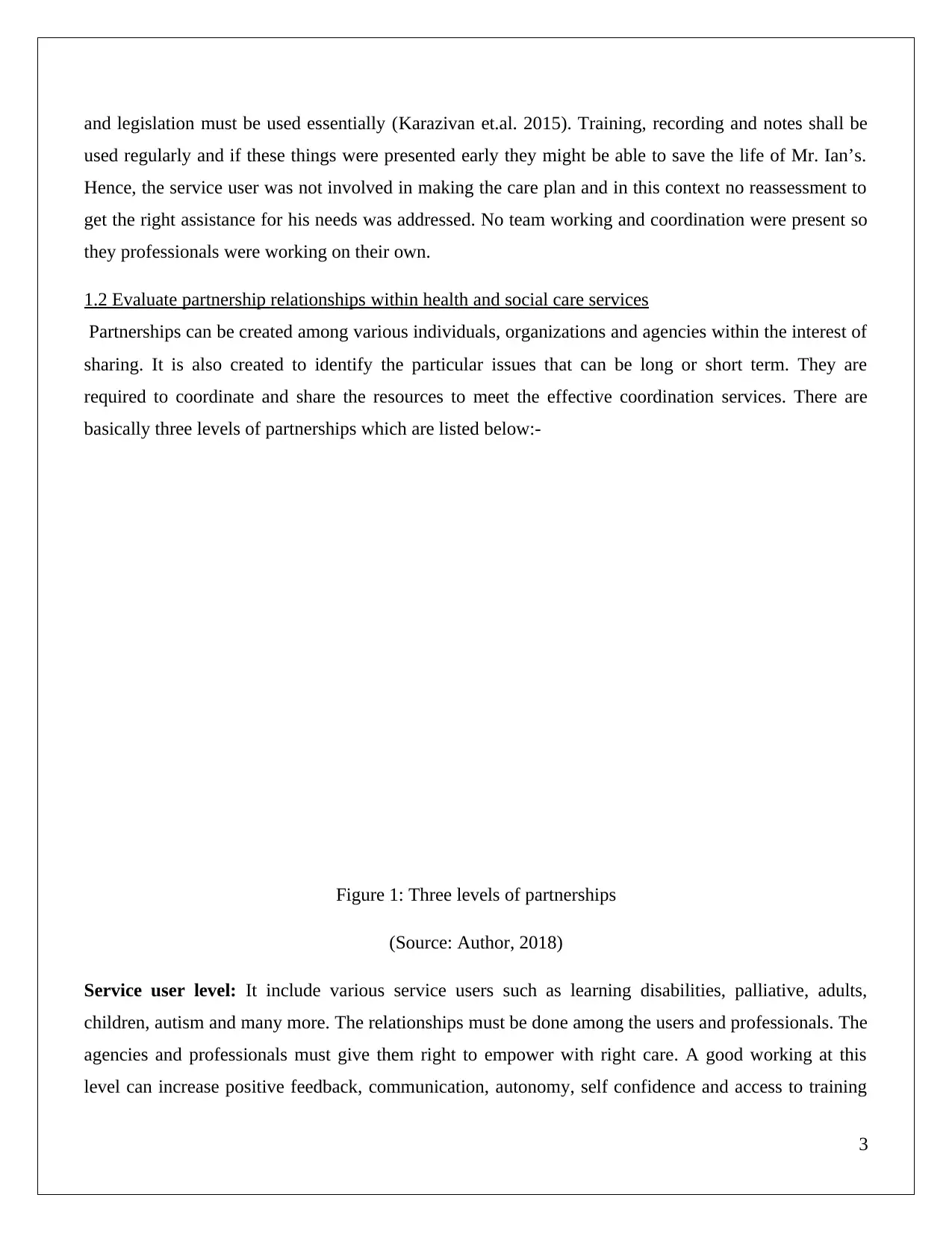
and legislation must be used essentially (Karazivan et.al. 2015). Training, recording and notes shall be
used regularly and if these things were presented early they might be able to save the life of Mr. Ian’s.
Hence, the service user was not involved in making the care plan and in this context no reassessment to
get the right assistance for his needs was addressed. No team working and coordination were present so
they professionals were working on their own.
1.2 Evaluate partnership relationships within health and social care services
Partnerships can be created among various individuals, organizations and agencies within the interest of
sharing. It is also created to identify the particular issues that can be long or short term. They are
required to coordinate and share the resources to meet the effective coordination services. There are
basically three levels of partnerships which are listed below:-
Figure 1: Three levels of partnerships
(Source: Author, 2018)
Service user level: It include various service users such as learning disabilities, palliative, adults,
children, autism and many more. The relationships must be done among the users and professionals. The
agencies and professionals must give them right to empower with right care. A good working at this
level can increase positive feedback, communication, autonomy, self confidence and access to training
3
used regularly and if these things were presented early they might be able to save the life of Mr. Ian’s.
Hence, the service user was not involved in making the care plan and in this context no reassessment to
get the right assistance for his needs was addressed. No team working and coordination were present so
they professionals were working on their own.
1.2 Evaluate partnership relationships within health and social care services
Partnerships can be created among various individuals, organizations and agencies within the interest of
sharing. It is also created to identify the particular issues that can be long or short term. They are
required to coordinate and share the resources to meet the effective coordination services. There are
basically three levels of partnerships which are listed below:-
Figure 1: Three levels of partnerships
(Source: Author, 2018)
Service user level: It include various service users such as learning disabilities, palliative, adults,
children, autism and many more. The relationships must be done among the users and professionals. The
agencies and professionals must give them right to empower with right care. A good working at this
level can increase positive feedback, communication, autonomy, self confidence and access to training
3
⊘ This is a preview!⊘
Do you want full access?
Subscribe today to unlock all pages.

Trusted by 1+ million students worldwide

range etc (Carpenter et.al. 2017). For example: in case of Mr. Ian’s the partnership working was poor, no
communication, negligence and confusion of part of professionals and no empowerment to patient and
further no clarity and collaboration in responsibilities.
Professional level: This people were carrying out their services in partnership to offer the care by
knowledge sharing and having the mutual objectives considering the service users needs. They are also
carrying out the work in collaboration to ensure plan and policies are structured and followed. But it also
includes some of the negative impacts like power struggle, bulk passing, various ideas, ineffective
communication, philosophies conflicts and lack of willingness. In the case of Mr. Ian’s, the
professionals did not commit and consider supportive needs along with it no risk assessment review,
safeguarding and supervision were done. Moreover, poor communication and coordination were highly
present in the death of Mr. Ian’s
Organizational level: It means working in partnership with the other ones. At this level, various
benefits such as information exchange, shared ideas and power, effective care of users of services, good
practice implementation and assuring them procedures and policies in integration with the vision of the
organizations and issues dealing prior they incur. Thus, when the organizations gives poor health
services and uses different policies and procedures that were not meant can create confusion and
disapprovals as well (Brett et.al. 2014). The same was happening in the case of Mr. Ian’s as no meeting
were held, no feedback and no information sharing was done and even service delivery were poor. Thus
partnership working must be such that it meets the every need of the individuals with trust, honesty and
openness.
In addition, there are guidelines that offer the framework for local authorities in working in partnership
that are Putting People First 2007, our say 2006, Our Health, Our Care, Mental Health Capacity Act
1999, Darzi Report 2008 and so on is explained below:
Health Act 1999 and NHS act 2005: In this act, the partners have to work in partnership to spend on the
single project. Further, partners join’s to deliver the services according to the needs of the service users.
The partnership objective in case of Mr. Ian’s was not specific as no collaboration between the partners
was present. Further, different opinions on risk assessment were presented and care methods were
inconsistent and present of more confusion related to meaning of care duty.
4
communication, negligence and confusion of part of professionals and no empowerment to patient and
further no clarity and collaboration in responsibilities.
Professional level: This people were carrying out their services in partnership to offer the care by
knowledge sharing and having the mutual objectives considering the service users needs. They are also
carrying out the work in collaboration to ensure plan and policies are structured and followed. But it also
includes some of the negative impacts like power struggle, bulk passing, various ideas, ineffective
communication, philosophies conflicts and lack of willingness. In the case of Mr. Ian’s, the
professionals did not commit and consider supportive needs along with it no risk assessment review,
safeguarding and supervision were done. Moreover, poor communication and coordination were highly
present in the death of Mr. Ian’s
Organizational level: It means working in partnership with the other ones. At this level, various
benefits such as information exchange, shared ideas and power, effective care of users of services, good
practice implementation and assuring them procedures and policies in integration with the vision of the
organizations and issues dealing prior they incur. Thus, when the organizations gives poor health
services and uses different policies and procedures that were not meant can create confusion and
disapprovals as well (Brett et.al. 2014). The same was happening in the case of Mr. Ian’s as no meeting
were held, no feedback and no information sharing was done and even service delivery were poor. Thus
partnership working must be such that it meets the every need of the individuals with trust, honesty and
openness.
In addition, there are guidelines that offer the framework for local authorities in working in partnership
that are Putting People First 2007, our say 2006, Our Health, Our Care, Mental Health Capacity Act
1999, Darzi Report 2008 and so on is explained below:
Health Act 1999 and NHS act 2005: In this act, the partners have to work in partnership to spend on the
single project. Further, partners join’s to deliver the services according to the needs of the service users.
The partnership objective in case of Mr. Ian’s was not specific as no collaboration between the partners
was present. Further, different opinions on risk assessment were presented and care methods were
inconsistent and present of more confusion related to meaning of care duty.
4
Paraphrase This Document
Need a fresh take? Get an instant paraphrase of this document with our AI Paraphraser
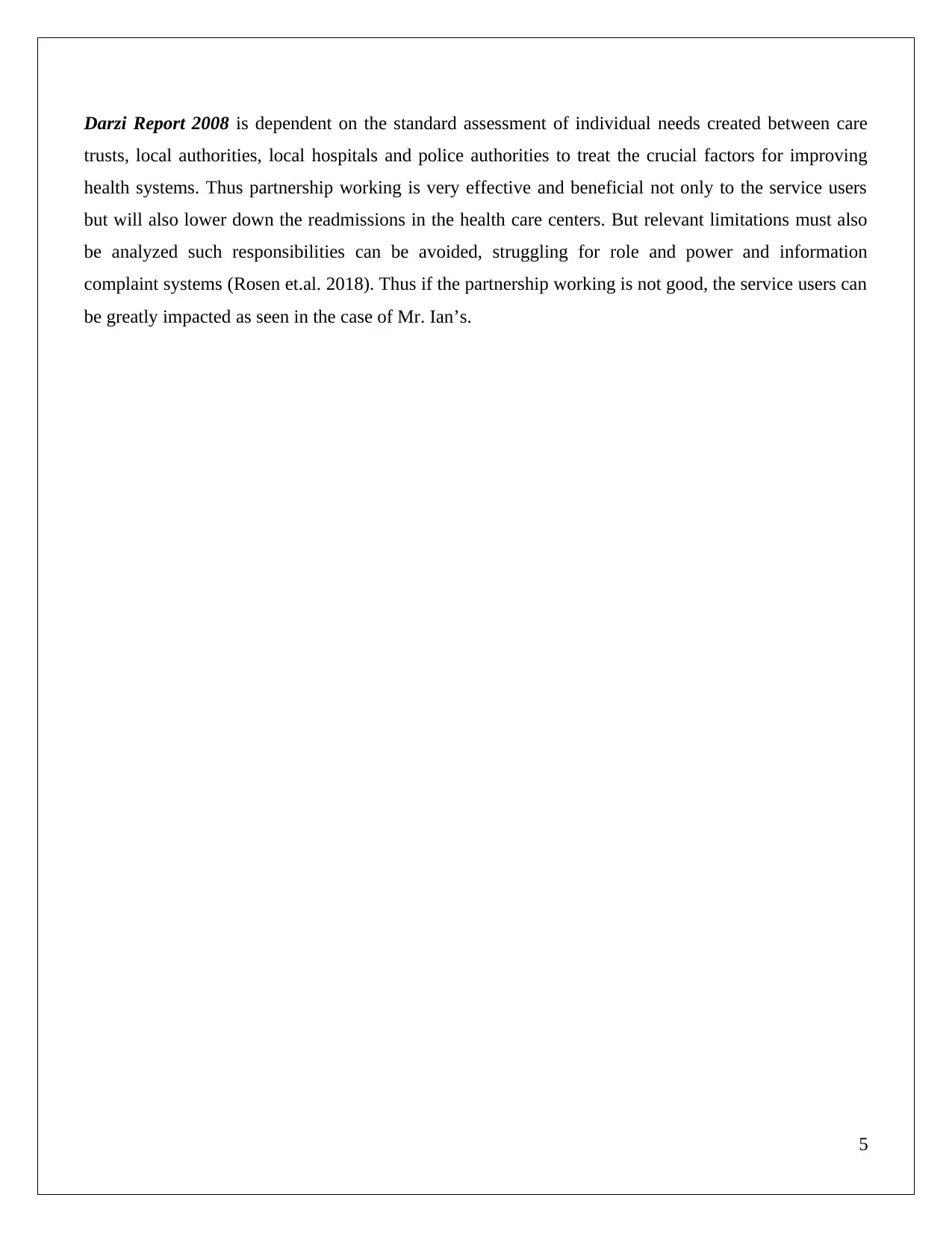
Darzi Report 2008 is dependent on the standard assessment of individual needs created between care
trusts, local authorities, local hospitals and police authorities to treat the crucial factors for improving
health systems. Thus partnership working is very effective and beneficial not only to the service users
but will also lower down the readmissions in the health care centers. But relevant limitations must also
be analyzed such responsibilities can be avoided, struggling for role and power and information
complaint systems (Rosen et.al. 2018). Thus if the partnership working is not good, the service users can
be greatly impacted as seen in the case of Mr. Ian’s.
5
trusts, local authorities, local hospitals and police authorities to treat the crucial factors for improving
health systems. Thus partnership working is very effective and beneficial not only to the service users
but will also lower down the readmissions in the health care centers. But relevant limitations must also
be analyzed such responsibilities can be avoided, struggling for role and power and information
complaint systems (Rosen et.al. 2018). Thus if the partnership working is not good, the service users can
be greatly impacted as seen in the case of Mr. Ian’s.
5

Section B
2.1 Analyze models of partnership working across the health and social care sector
The several types of models provide empowerment, decision making, confidentiality and making
informed choices. Various agencies must assure positive working in partnership that includes all the
things mentioned.
Figure 2: Models of partnership working
(Source: Author, 2018)
Unified model: No gaps and service duplication can be seen in this model. This model is used by NHS
Northern Ireland practices due to the fact that this model controls the various sectors with the centralized
system. No innovation, negligence of some areas and moving in same directions are the limitations of
this model (Glasby, 2017). In case of Mr. Ian’s the professionals were working in partnership yet the
coordination was not presented and no roles and responsibilities and service user was not given chance
to take part in decision making about his own care.
6
HybridModel
2.1 Analyze models of partnership working across the health and social care sector
The several types of models provide empowerment, decision making, confidentiality and making
informed choices. Various agencies must assure positive working in partnership that includes all the
things mentioned.
Figure 2: Models of partnership working
(Source: Author, 2018)
Unified model: No gaps and service duplication can be seen in this model. This model is used by NHS
Northern Ireland practices due to the fact that this model controls the various sectors with the centralized
system. No innovation, negligence of some areas and moving in same directions are the limitations of
this model (Glasby, 2017). In case of Mr. Ian’s the professionals were working in partnership yet the
coordination was not presented and no roles and responsibilities and service user was not given chance
to take part in decision making about his own care.
6
HybridModel
⊘ This is a preview!⊘
Do you want full access?
Subscribe today to unlock all pages.

Trusted by 1+ million students worldwide
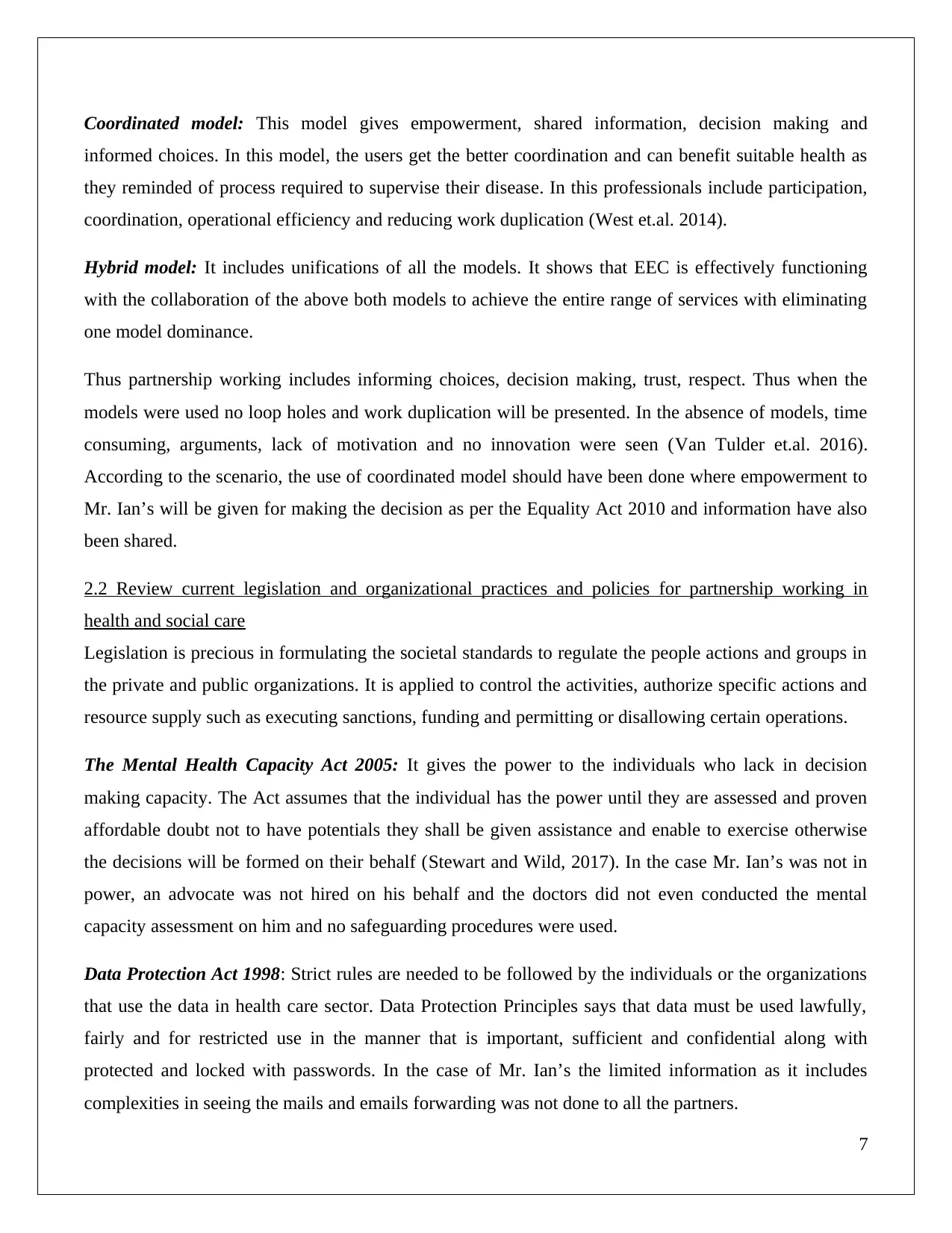
Coordinated model: This model gives empowerment, shared information, decision making and
informed choices. In this model, the users get the better coordination and can benefit suitable health as
they reminded of process required to supervise their disease. In this professionals include participation,
coordination, operational efficiency and reducing work duplication (West et.al. 2014).
Hybrid model: It includes unifications of all the models. It shows that EEC is effectively functioning
with the collaboration of the above both models to achieve the entire range of services with eliminating
one model dominance.
Thus partnership working includes informing choices, decision making, trust, respect. Thus when the
models were used no loop holes and work duplication will be presented. In the absence of models, time
consuming, arguments, lack of motivation and no innovation were seen (Van Tulder et.al. 2016).
According to the scenario, the use of coordinated model should have been done where empowerment to
Mr. Ian’s will be given for making the decision as per the Equality Act 2010 and information have also
been shared.
2.2 Review current legislation and organizational practices and policies for partnership working in
health and social care
Legislation is precious in formulating the societal standards to regulate the people actions and groups in
the private and public organizations. It is applied to control the activities, authorize specific actions and
resource supply such as executing sanctions, funding and permitting or disallowing certain operations.
The Mental Health Capacity Act 2005: It gives the power to the individuals who lack in decision
making capacity. The Act assumes that the individual has the power until they are assessed and proven
affordable doubt not to have potentials they shall be given assistance and enable to exercise otherwise
the decisions will be formed on their behalf (Stewart and Wild, 2017). In the case Mr. Ian’s was not in
power, an advocate was not hired on his behalf and the doctors did not even conducted the mental
capacity assessment on him and no safeguarding procedures were used.
Data Protection Act 1998: Strict rules are needed to be followed by the individuals or the organizations
that use the data in health care sector. Data Protection Principles says that data must be used lawfully,
fairly and for restricted use in the manner that is important, sufficient and confidential along with
protected and locked with passwords. In the case of Mr. Ian’s the limited information as it includes
complexities in seeing the mails and emails forwarding was not done to all the partners.
7
informed choices. In this model, the users get the better coordination and can benefit suitable health as
they reminded of process required to supervise their disease. In this professionals include participation,
coordination, operational efficiency and reducing work duplication (West et.al. 2014).
Hybrid model: It includes unifications of all the models. It shows that EEC is effectively functioning
with the collaboration of the above both models to achieve the entire range of services with eliminating
one model dominance.
Thus partnership working includes informing choices, decision making, trust, respect. Thus when the
models were used no loop holes and work duplication will be presented. In the absence of models, time
consuming, arguments, lack of motivation and no innovation were seen (Van Tulder et.al. 2016).
According to the scenario, the use of coordinated model should have been done where empowerment to
Mr. Ian’s will be given for making the decision as per the Equality Act 2010 and information have also
been shared.
2.2 Review current legislation and organizational practices and policies for partnership working in
health and social care
Legislation is precious in formulating the societal standards to regulate the people actions and groups in
the private and public organizations. It is applied to control the activities, authorize specific actions and
resource supply such as executing sanctions, funding and permitting or disallowing certain operations.
The Mental Health Capacity Act 2005: It gives the power to the individuals who lack in decision
making capacity. The Act assumes that the individual has the power until they are assessed and proven
affordable doubt not to have potentials they shall be given assistance and enable to exercise otherwise
the decisions will be formed on their behalf (Stewart and Wild, 2017). In the case Mr. Ian’s was not in
power, an advocate was not hired on his behalf and the doctors did not even conducted the mental
capacity assessment on him and no safeguarding procedures were used.
Data Protection Act 1998: Strict rules are needed to be followed by the individuals or the organizations
that use the data in health care sector. Data Protection Principles says that data must be used lawfully,
fairly and for restricted use in the manner that is important, sufficient and confidential along with
protected and locked with passwords. In the case of Mr. Ian’s the limited information as it includes
complexities in seeing the mails and emails forwarding was not done to all the partners.
7
Paraphrase This Document
Need a fresh take? Get an instant paraphrase of this document with our AI Paraphraser
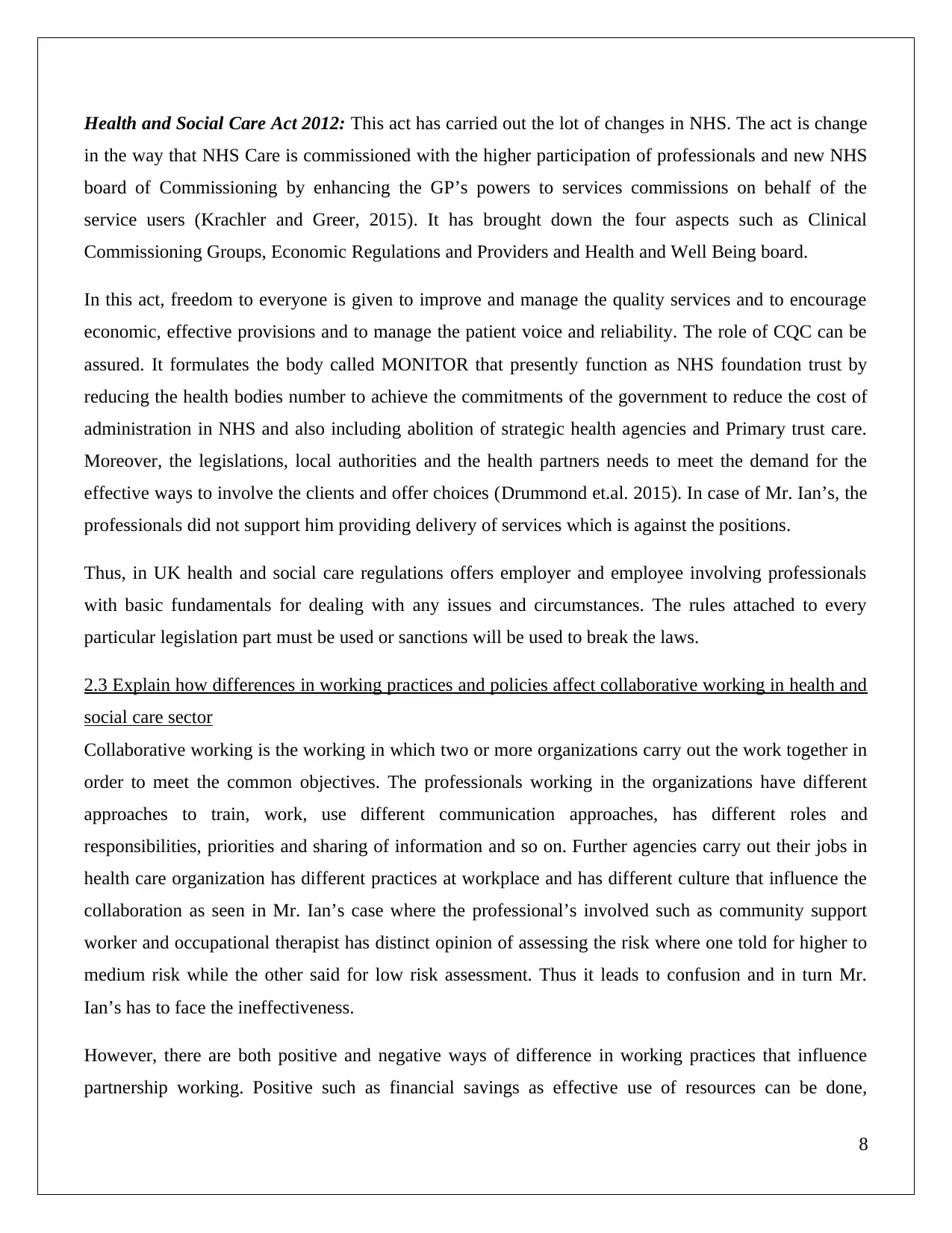
Health and Social Care Act 2012: This act has carried out the lot of changes in NHS. The act is change
in the way that NHS Care is commissioned with the higher participation of professionals and new NHS
board of Commissioning by enhancing the GP’s powers to services commissions on behalf of the
service users (Krachler and Greer, 2015). It has brought down the four aspects such as Clinical
Commissioning Groups, Economic Regulations and Providers and Health and Well Being board.
In this act, freedom to everyone is given to improve and manage the quality services and to encourage
economic, effective provisions and to manage the patient voice and reliability. The role of CQC can be
assured. It formulates the body called MONITOR that presently function as NHS foundation trust by
reducing the health bodies number to achieve the commitments of the government to reduce the cost of
administration in NHS and also including abolition of strategic health agencies and Primary trust care.
Moreover, the legislations, local authorities and the health partners needs to meet the demand for the
effective ways to involve the clients and offer choices (Drummond et.al. 2015). In case of Mr. Ian’s, the
professionals did not support him providing delivery of services which is against the positions.
Thus, in UK health and social care regulations offers employer and employee involving professionals
with basic fundamentals for dealing with any issues and circumstances. The rules attached to every
particular legislation part must be used or sanctions will be used to break the laws.
2.3 Explain how differences in working practices and policies affect collaborative working in health and
social care sector
Collaborative working is the working in which two or more organizations carry out the work together in
order to meet the common objectives. The professionals working in the organizations have different
approaches to train, work, use different communication approaches, has different roles and
responsibilities, priorities and sharing of information and so on. Further agencies carry out their jobs in
health care organization has different practices at workplace and has different culture that influence the
collaboration as seen in Mr. Ian’s case where the professional’s involved such as community support
worker and occupational therapist has distinct opinion of assessing the risk where one told for higher to
medium risk while the other said for low risk assessment. Thus it leads to confusion and in turn Mr.
Ian’s has to face the ineffectiveness.
However, there are both positive and negative ways of difference in working practices that influence
partnership working. Positive such as financial savings as effective use of resources can be done,
8
in the way that NHS Care is commissioned with the higher participation of professionals and new NHS
board of Commissioning by enhancing the GP’s powers to services commissions on behalf of the
service users (Krachler and Greer, 2015). It has brought down the four aspects such as Clinical
Commissioning Groups, Economic Regulations and Providers and Health and Well Being board.
In this act, freedom to everyone is given to improve and manage the quality services and to encourage
economic, effective provisions and to manage the patient voice and reliability. The role of CQC can be
assured. It formulates the body called MONITOR that presently function as NHS foundation trust by
reducing the health bodies number to achieve the commitments of the government to reduce the cost of
administration in NHS and also including abolition of strategic health agencies and Primary trust care.
Moreover, the legislations, local authorities and the health partners needs to meet the demand for the
effective ways to involve the clients and offer choices (Drummond et.al. 2015). In case of Mr. Ian’s, the
professionals did not support him providing delivery of services which is against the positions.
Thus, in UK health and social care regulations offers employer and employee involving professionals
with basic fundamentals for dealing with any issues and circumstances. The rules attached to every
particular legislation part must be used or sanctions will be used to break the laws.
2.3 Explain how differences in working practices and policies affect collaborative working in health and
social care sector
Collaborative working is the working in which two or more organizations carry out the work together in
order to meet the common objectives. The professionals working in the organizations have different
approaches to train, work, use different communication approaches, has different roles and
responsibilities, priorities and sharing of information and so on. Further agencies carry out their jobs in
health care organization has different practices at workplace and has different culture that influence the
collaboration as seen in Mr. Ian’s case where the professional’s involved such as community support
worker and occupational therapist has distinct opinion of assessing the risk where one told for higher to
medium risk while the other said for low risk assessment. Thus it leads to confusion and in turn Mr.
Ian’s has to face the ineffectiveness.
However, there are both positive and negative ways of difference in working practices that influence
partnership working. Positive such as financial savings as effective use of resources can be done,
8
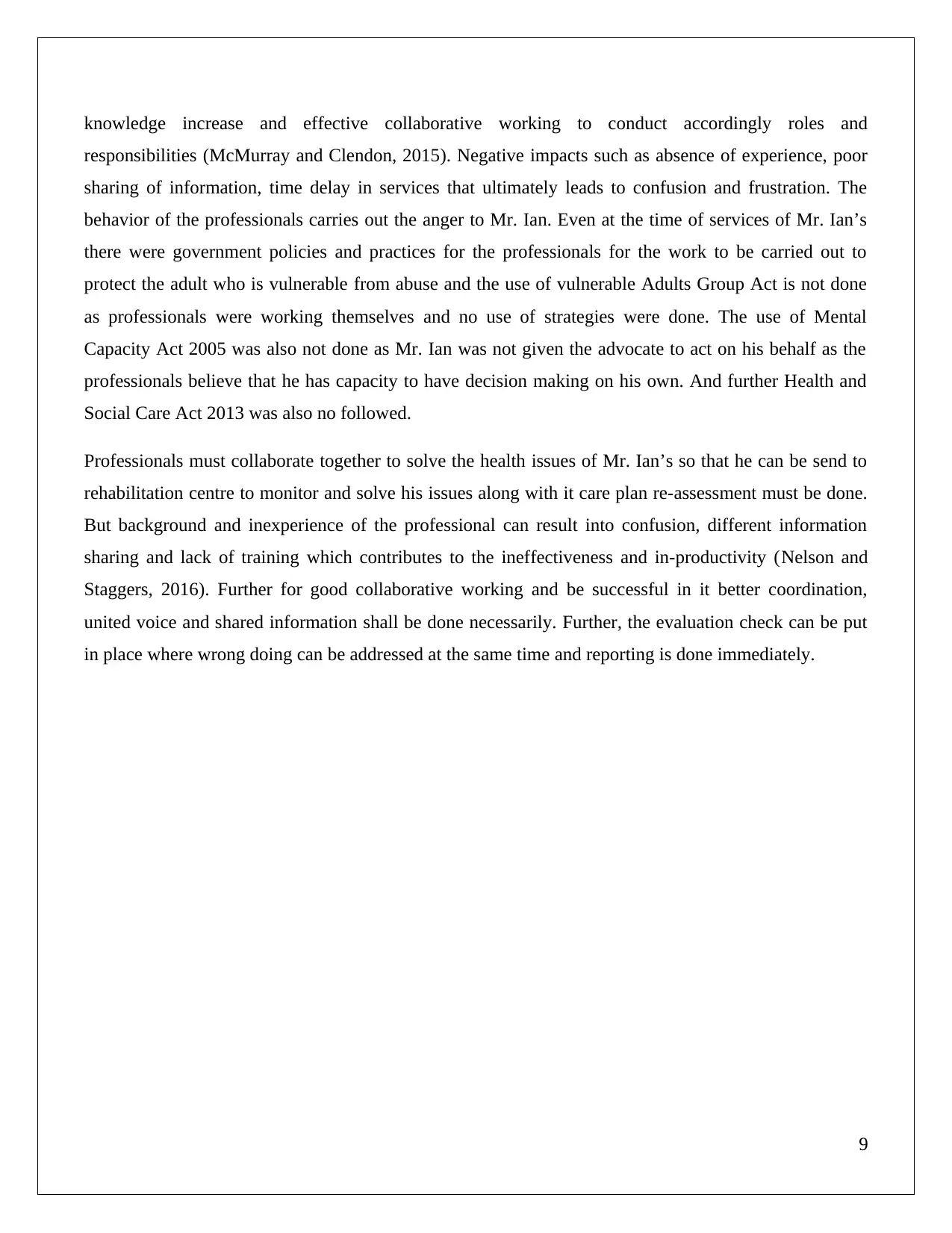
knowledge increase and effective collaborative working to conduct accordingly roles and
responsibilities (McMurray and Clendon, 2015). Negative impacts such as absence of experience, poor
sharing of information, time delay in services that ultimately leads to confusion and frustration. The
behavior of the professionals carries out the anger to Mr. Ian. Even at the time of services of Mr. Ian’s
there were government policies and practices for the professionals for the work to be carried out to
protect the adult who is vulnerable from abuse and the use of vulnerable Adults Group Act is not done
as professionals were working themselves and no use of strategies were done. The use of Mental
Capacity Act 2005 was also not done as Mr. Ian was not given the advocate to act on his behalf as the
professionals believe that he has capacity to have decision making on his own. And further Health and
Social Care Act 2013 was also no followed.
Professionals must collaborate together to solve the health issues of Mr. Ian’s so that he can be send to
rehabilitation centre to monitor and solve his issues along with it care plan re-assessment must be done.
But background and inexperience of the professional can result into confusion, different information
sharing and lack of training which contributes to the ineffectiveness and in-productivity (Nelson and
Staggers, 2016). Further for good collaborative working and be successful in it better coordination,
united voice and shared information shall be done necessarily. Further, the evaluation check can be put
in place where wrong doing can be addressed at the same time and reporting is done immediately.
9
responsibilities (McMurray and Clendon, 2015). Negative impacts such as absence of experience, poor
sharing of information, time delay in services that ultimately leads to confusion and frustration. The
behavior of the professionals carries out the anger to Mr. Ian. Even at the time of services of Mr. Ian’s
there were government policies and practices for the professionals for the work to be carried out to
protect the adult who is vulnerable from abuse and the use of vulnerable Adults Group Act is not done
as professionals were working themselves and no use of strategies were done. The use of Mental
Capacity Act 2005 was also not done as Mr. Ian was not given the advocate to act on his behalf as the
professionals believe that he has capacity to have decision making on his own. And further Health and
Social Care Act 2013 was also no followed.
Professionals must collaborate together to solve the health issues of Mr. Ian’s so that he can be send to
rehabilitation centre to monitor and solve his issues along with it care plan re-assessment must be done.
But background and inexperience of the professional can result into confusion, different information
sharing and lack of training which contributes to the ineffectiveness and in-productivity (Nelson and
Staggers, 2016). Further for good collaborative working and be successful in it better coordination,
united voice and shared information shall be done necessarily. Further, the evaluation check can be put
in place where wrong doing can be addressed at the same time and reporting is done immediately.
9
⊘ This is a preview!⊘
Do you want full access?
Subscribe today to unlock all pages.

Trusted by 1+ million students worldwide
1 out of 18
Related Documents
Your All-in-One AI-Powered Toolkit for Academic Success.
+13062052269
info@desklib.com
Available 24*7 on WhatsApp / Email
![[object Object]](/_next/static/media/star-bottom.7253800d.svg)
Unlock your academic potential
Copyright © 2020–2025 A2Z Services. All Rights Reserved. Developed and managed by ZUCOL.




